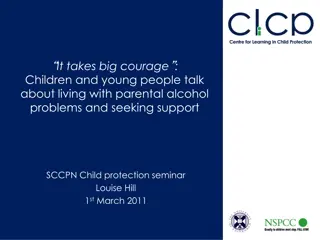Understanding the Development of Fears: Individual and Parental Influences
Exploring the impact of individual characteristics and parental dispositions on learned animal fears, this study delves into the prevalence of phobias, the development of fears and phobias, fears through the transmission of information, and the role of these factors in childhood fear acquisition. The study aims to uncover how children process negative information and develop fears, shedding light on the interplay between individual traits and parental influences.
Uploaded on Sep 09, 2024 | 0 Views
Download Presentation

Please find below an Image/Link to download the presentation.
The content on the website is provided AS IS for your information and personal use only. It may not be sold, licensed, or shared on other websites without obtaining consent from the author. Download presentation by click this link. If you encounter any issues during the download, it is possible that the publisher has removed the file from their server.
E N D
Presentation Transcript
Contributors to the Development of Fears: The Influence of Individual Characteristics and Parental Disposition on Learned Animal Fears Raghad Hassabelnaby & Megan Conrad, Ph.D Department of Psychology William Paterson University
Prevalence of Phobias In the United States, nearly 7-9% of adults and 5% of children are diagnosed with specific phobia (American Psychiatric Association [APA], 2013). Specific phobias often begin at a young age, with animal phobias having the earliest onset around the age of 7 years, and carry into adulthood (Muris & Field, 2010; APA, 2013).
Development of Fears and Phobias Behavioral-genetic research has shown that genetic factors can make up to 50% of the variance for some childhood fears (Gregory & Eley, 2007). However, Rachman s (1977) theory of fear acquisition postulates that fear can be learned through three pathways: 1) direct personal experience 2) observation 3) the transmission of negative information Animal fears can also be elicited from verbal threat information, such as that transmitted by caregivers (Hadwin et al., 2006).
Fears Through Transmission of Information The most common pathway for the acquisition of fears for most children (89%) has been cited due to negative information or instruction as the origin of their early fears (Ollendick & King, 1991). Thus, the transmission of negative information is a crucial component of fear development in children. Previous research using prospective designs have shown that children can acquire fear about a novel stimulus after hearing negative information (see Muris & Field, 2010 for a review). However, few studies have examined how fear may develop in natural settings and how individual differences contribute to this. One way negative information is often transmitted to children is through everyday activities (e.g., reading a book). Understanding how individual and parental differences influence the processing of this information and development of fears in daily activities is fundamental.
The Present Study The current study examined the role of two potential factors in the development of early animal avoidance: We aimed to examine the child s animal fears and avoidance, after a storybook was presented to the child containing two different animals. 1. individual characteristics of child (i.e., anxiety, fear) 2. parental dispositions (animal fear)
Method- Participants 96 Children Ages 4 - 7 years and 11 months (M = 5.38, SD = 1.14) 50 females (52.1%) Majority of participants self-identified as Caucasian (70.3%) or African American (24.2%) Largely middle class sample 72.4% reported being above median household income level
Method- Materials and Measures Parents completed a questionnaire including (Predictor Variables) Family demographic information Child Behavior Questionnaire (CBQ; four subsections: approach/positive anticipation, fear, impulsivity, and inhibitory control; Putnam & Rothbart, 2006) to measure their child s behavior Preschool Anxiety Scale (PAS; Spence, Rapee, McDonald, & Ingram, 2001) to measure their child s anxiety level The Snake Questionnaire (SNAQ; Klorman, Weerts, Hastings, Melamed, & Lang, 1974), a 30-item true/false questionnaire which measures the parent s own fear of snakes. For families with pets, parents completed the Pet Attachment Scale- Parent Report (PAS-PR; Melson, 1988), which measures the amount of time children spent on pet-related activities. Finally, questions were asked regarding their child s fear of and experiences with live frogs and snakes and their child s and their own interest in and knowledge about animals.
Method- Materials and Measures Cont. Storybooks ( Threatening animal = snake; non-threatening animal = frog) Positive scripts described the animals as gentle, sociable, and loved by others. The negative scripts described the animals as threatening, dangerous, and dirty. The only difference between the snake and frog books were the animal name. Memory assessment (26 questions) To examine the degree to which they attributed positive and negative traits to the snake/frog. Outcome Variables: Modified version of the Fear Beliefs Questionnaire (FBQ [10 items]; Field & Lawson, 2003) Asked children to endorse various statements about the animals and situations involving them to measure fear of the snake or frog Behavioral Approach Task (BAT; Field & Lawson, 2003) A realistic toy snake and frog were used as the animals. A wooden crate with a hole in the top housed the animals. The crate was designed such that children could reach inside, if they desired (to measure avoidance), but could not see into it.
Method- Procedure Children tested in university lab Participant randomly assigned to and read one of four storybook conditions: 1. Negative snake 2. Positive snake 3. Negative frog 4. Positive frog Same storybook was read to child twice Child asked randomized memory questions for comprehension of story book information
Method- Procedure Cont. Then verbal measure of fear, the FBQ, was administered Finally, the behavior measurement of fear/avoidance was completed, using the BAT **After completing the post-test assessments, the experimenter read a new book and the entire procedure was repeated for the other animal with the opposite valence (i.e. if positive snake was first, then negative frog was second). **During this time, parent(s) completed the demographic information
Child Differences on Outcome Measures Children s individual differences were found to predict avoidance and fear behavior. On the BAT, children who avoided the animals had higher anxiety (PAS), t(77) = 3.99, p < .001. Similarly, children who avoided the animals were rated as more fearful (CBQ-Fear) by parents t(79) = 3.08, p = .003, (Figure 1). Children who are more anxious also reported greater fear (FBQ) of the animals (r(80) = .288, p = .010) (Figure 1).
35 Yes No 30 25 20 Score 15 10 5 0 CBQ PAS BAT (Reach for Animal) Figure 1. CBQ Fear score and PAS score by Behavioral Avoidance Task (BAT).
Parental Dispositions on Perception of Child Parent s fears also related to children s fear/anxiety. Parents who are more afraid of snakes (SNAQ) rated their children as higher in anxiety (r(81) = .354, p = .001) and fear (r(81) = .316, p = .004). Parents who scored higher on the SNAQ, had a lower rating of interest and knowledge of animals for themselves and their children, and also believed that their children had a higher fear of snakes and frogs (Table 1, correlation-matrix).
Table 1 Descriptive and Correlations Statistics for Parent s Ratings and SNAQ. Item 1 2 3 4 5 6 M (SD) 1. Parent s own knowledge of animals - 3.53(.81) .67** 3.57 (.84) 2. Parent s own interest in animals - .27** .28** 3.49 (.74) 3. Parent s rating of child s knowledge of animals - .22** .29** .53** 3.48 (.81) 4. Parent s rating of child s interest in animals - -.13 -.25 -.29 -.20 3.17 (.697) 5. Parent s rating of child s fear of snakes - -.31 -.50** -.27 -.12 .63** 2.00 (1.02) 6. Parent s rating of child s fear of frogs -.26* -.33** -.20 -.28* .66** .59** 6.49 (6.13) 7. Parent s SNAQ score Note. Items 1-6 were measured using a 5-point Likert scale. SNAQ Scale scores ranged from 0-30; in this sample score ranged from 0-27. *p < .05, **p < .01
Parental Differences on Childrens Outcome Measures Importantly, parent s own fears predicted children s learned fears. When children were presented with negative information about non- threatening animals (frogs), their parent s own animal fears predicted their learned fears (FBQ; r(20) = .468, p = .037). This relationship was not significant for the other three conditions, all p s > .135.
Discussion of Results Our results emphasize the importance of both individual differences and parental dispositions in the development of early animal fears. Parent s approach toward their children is likely related to their own anxiety/fears Children with anxious tendencies are more likely to avoid animals and be more fearful Clinical Implications Addressing parent-child interactions of anxious parents may help to limit the fear ideations and avoidance that are transmitted to and effect children daily.
Limitations and Future Direction Limitations No control group. Lack of diversity among sample (e.g., largely middle class, white) limits generalizability. Future Direction Future research should investigate parental beliefs, parent-child interactions, and the direct influence of these on children s anxiety and, consequent fear/avoidance. Anxious caregivers provide more negative information to their children than non- anxious caregivers (Muris, van Zwol, Huijding, & Mayer, 2010; Murray, Pella, Pascalis, Arteche, Pass, Percy, Creswell, & Cooper, 2014). Replication of this study with a control group and parents creating their own script for the wordless picture book may allows us to examine direct differences between parents and the effect on their child s fear/avoidance.
For Questions or Comments please contact: hassabelnabyr@student. wpunj.edu Thank you!
References American Psychiatric Association. (2013). Diagnostic and statistical manual of mental disorders, fifth edition. Arlington, VA: American Psychiatric Publishing. Gregory, A. M., & Eley, T. C. (2007). Genetic influences on anxiety in children: What we ve learned and where we re heading. Clinical Child and Family Psychology Review, 10(3), 199-212. Hadwin, J. A., Garner, M., & Perez-Olivas, G. (2006). The development of information processing biases in childhood anxiety: A review and exploration of its origins in parenting. Clinical Psychology Review, 26, 876 894. Muris, P., & Field, A.P. (2010). The role of verbal threat information in the development of childhood fear. Beware the Jabberwock! . Clinical Child and Family Psychology Review, 13(2), 129-150. Muris, P., van Zwol, L., Huijding, J., & Mayer, B. (2010). Mom told me scary things about this animal: Parents installing fear beliefs in their children via the verbal information pathway. Behaviour research and therapy, 48(4), 341-346. Murray, L., Pella, J. E., De Pascalis, L., Arteche, A., Pass, L., Percy, R., ... & Cooper, P. J. (2014). Socially anxious mothers' narratives to their children and their relation to child representations and adjustment. Development and Psychopathology, 26(4pt2), 1531-1546. Ollendick, T. H., & King, N. J. (1991). Origins of childhood fears: An evaluation of Rachman's theory of fear acquisition. Behaviour Research and Therapy, 29, 117 123. Rachman, S. J. (1977). The conditioning theory of fear acquisition: A critical examination. Behaviour Research and Therapy, 15, 372 387.























